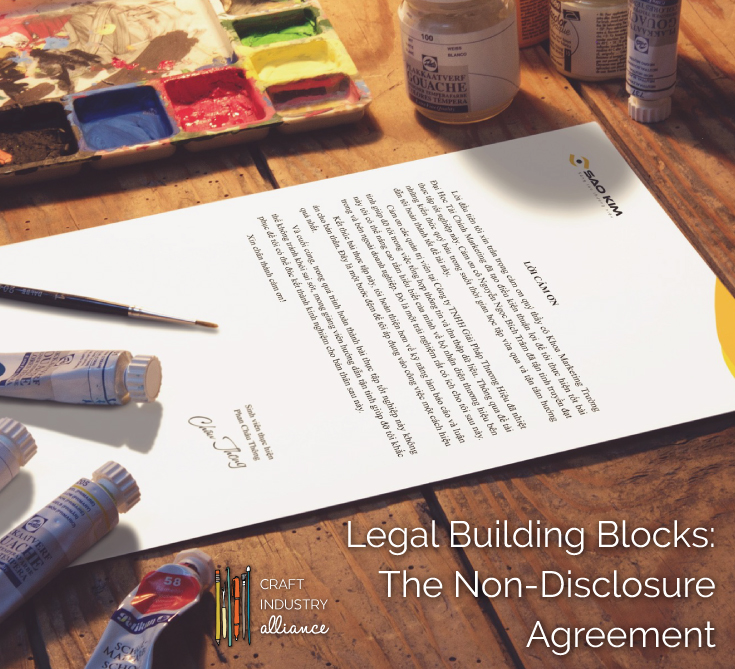
- financial information about your business,
- customer and e-newsletter lists,
- research about future products you’re developing,
- lists of suppliers that you spent years tracking down,
- a software program that you created.
While most businesses have information they’d like to keep confidential, many business owners don’t think about protecting that information until it’s too late. One way to protect your valuable business information before it falls into a competitor’s hands is through the careful use of non-disclosure agreements.
What is a Non-Disclosure Agreement?
A non-disclosure agreement (NDA) is a contract that legally obligates a party to keep certain information confidential. An NDA is used when two parties must share information for a specific purpose, but the owner of the information does not want the information revealed to the general public or its business competitors. The NDA defines what information is protected and for how long, and provides a basis for the owner to seek relief from a court if its terms are broken.
When should you use an NDA?
Perhaps the most common use of an NDA is when a business employs sales representatives. A sales rep is usually given access to loads of valuable information about her employer’s business: customer lists and profiles, sales records, lists of prospective customers, discounts and other special pricing arrangements, and so on. If that sales rep were to leave and go work for a direct competitor of the business, the sales rep could use all of that information like a road map to unfairly compete against the former employer. But if the sales rep signs an NDA, she is then legally bound to refrain from passing on her former employer’s information or to use it to benefit herself.
NDAs are useful in many contexts other than sales. If you are considering selling your business or taking on a new partner, you will have to disclose a great deal of sensitive information, including financial data, sales records, projections for future growth, and marketing data. Disclosing that much information to a third party is daunting—what if the other party refuses to do the deal and walks away with all your sensitive business information? Having the prospective purchaser or investor sign an NDA before disclosing that information provides you with protection.
Think of the many times you are asked to provide confidential business information to a third party, and you’ll see how useful the protection of an NDA can be. Hiring a consultant or marketing expert? You’ll need to hand over information about your business’s sales and operations so the consultant has the necessary background. Training a new employee how to use specialized equipment or mix up a unique dye? Giving a computer consultant data to tweak software to your business’s specs? Providing a mill or bead manufacturer with very specific parameters for a new product? All of these are situations where it might be appropriate to use an NDA.
Limits on NDAs
While NDAs can protect a business owner from widespread disclosure of sensitive information, NDAs are not without limits. Because enforcing an NDA can limit an individual’s employment choices and restrict speech, courts don’t always enforce them and tend to construe them very narrowly. Courts are especially hostile to NDAs where they seem especially broad and overly restrictive. An NDA that purports to be in effect for fifty years, for example, will probably not be enforced for that length of time. Here are some issues to consider when creating an NDA:
- How long should the NDA stay in effect? The exact period of time will depend on the kind of information being protected and the nature of the business. In some cases, a period of six months to one year is appropriate; for others, a longer term may be permissible. Just keep in mind that generally speaking, the longer the period of time, the less likely a court is to enforce the NDA.
- What kind of information should be protected? Not just any information is protectable (for example, you can’t claim that publicly-available information is protected), so give serious thought to what you want to protect. Describe the information as specifically as you can. It’s not enough to rely on vague phrases like “sensitive information”; instead, you’ve got to provide a meaningful description of the proprietary information without disclosing it in the process.
- Who is allowed to have access to the information? Be specific about who is subject to the NDA and make sure that any third parties who may need access to the information are required to sign an NDA.
- Are there any exclusions to the NDA? For instance, often NDAs include a provision that allows the signatory to disclose information when required by court order or other legal process.
Things to Remember
If you need to enforce your NDA, you’ll be in a much better position if you can show that you took steps to protect confidential information in addition to the NDA. Consider using common-sense precautions to protect sensitive information. These steps are easy but effective ways to bolster your protection:
- restrict access to paperwork or computers that contain sensitive information, perhaps with a password,
- label or stamp documents “CONFIDENTIAL,”
- keep proprietary information separate from non-protected information,
- be mindful of what you post on social media—photographs showing how you create a product are fun to post, but may suggest that your process isn’t actually that secret anymore.
And as always, it’s best to seek advice from a licensed attorney in the appropriate jurisdiction, particularly if your individual situation is complex or involves substantial intellectual property issues.
Note: This article does not constitute legal advice nor does it create an attorney-client relationship. It is provided for educational purposes only. The opinions expressed are those of the author only.
Click here to download the Sample Non-Disclosure Agreement. (It’s acceptable to copy legal language and use it when drafting your own agreements. Legal language isn’t itself protected by copyright.)

Carol Sulcoski
contributor
Carol J. Sulcoski is an attorney by day and a knitting author, designer and dyer by night. Her latest book is “Yarn Substitution Made Easy” (Lark Crafts 2019). She lives outside Philadelphia with her three nearly grown-up children and a fluffy orange cat.


Very useful thank you Carol. I used a NDA when taking on a new business partner. I had to share all the details of my business and how much it earned before she could consider buying in, but equally I didn’t want her to be able to share that information if she had decided not to become my partner. I wrote mine from scratch, so handy to have a template for future use.